May 5 - May 7, 2007
Getting to Raccoon Cay was an easy 5 mile trip from Buenavista, short enough for us to even tow Fin (the dinghy) behind us. The anchoring area for our current wind conditions was easily accessed and was totally vacant, so we had our pick of where to drop the hook. There are no raccoons here now, but some of the islands have a few.
We're right next to a tiny cay that the fisherman use to store some fishing traps on and to roast bait to put in their traps: a boat has come by several times to start up a little fire and then take off again. Eddie and I were out on a snorkel expedition and the fishermen came up to us (probably to check out our gear and see what we were doing), so I asked them what they were burning on the island, and I got the info from the native's lips. He told me they were trying to catch grouper with the roasted bait. It sure looks like a tough job to us.
The big island
No, not in Hawaii, here at Raccoon Cay; the largest one we have visited, a little over 3 miles long and a half mile wide. Beacon Hill, the highest point on the island towers 120' above.
There are numerous ruins, of buildings and pasture fences. Salt was once gathered here from the inland ponds. In more modern times, someone tried to raise cattle. Now the island has a large population of goats and a small one of sheep – we hear lots of bleats and baas! The Ragged Islanders come here to hunt them, but goat and mutton won't be on any menu on FLUKE.
The terrain is distinctive and unique from the other cays we have visited. The narrow strip of beach on the side of our anchorage varies from having the rocky limestone outcroppings, smooth slab rocks, and fine sand. There are even a couple of little coves that have some small clumps of mangroves growing in them. Along much of the island after you leave the beach, a gentle incline takes you to a distinctive dune line, the habitat for the pretty palmate Thrinax palms. Any one low enough for a goat to reach, standing on its back legs and neck stretched fully out, has had all its fruit stripped off. The trunks house large numbers of a land snail.
The dune drops off to lowland areas, with small ponds surrounded by rocky ground where the silver buttonwoods thrive. Hills rise up from these areas and lead towards the ocean side with its rocky shore of big, sharp boulders.
Island highs and lows
Eddie has been nursing some sort of ear infection, but I whined enough to get him to go snorkeling with me in Horsehead Bay, a short dinghy ride from where FLUKE is anchored. It is a wonderful spot with colorful coral heads, an interesting drop off, a great variety of fish, and we even found a hidey hole containing 5 nice lobster. We just enjoyed spying on them; lobster is out of season now, and we aren't starving to the point where we need to break the rules.
The whole crew lathered up heavily with sunscreen for the big land tour. I was very vocal about wanting to try to find a path up to Beacon Hill, but was overruled, so settled for a calmer, but still interesting, morning in the lower elevations. We'll hike that peak on the next trip!
After 3 attempts involving landing on different beaches, we managed to find the trail head to the blue hole that we could see marked on the map, but it wasn't really clear exactly where the hole was. We clearly marked it so subsequent adventurers could save some time. These land blue holes, despite their distance from the water or elevation, are connected to the sea by underground channels so that they are tidal, getting fresh water from the sea with each ebb and flow. You never know what may be in one, but this one just had a few small fish. It is still fascinating to look at the cavernous hole with the dark blue water right in the limestone rock.
With minimal effort we found a well-marked wide trail that started along the dune line, went around the perimeter of a large salt pond, snaked easily up over one of the hills, following some of the pasture wall ruins, all the way to the ocean side.
We scavenged through all the trash and debris, but alas, no glass ball yet! Eddie and I took a small detour at one point, finding a shaded area where there was a large herd of goats. They snorted, bleated, and stomped at us and then reluctantly moved on. When we walked through the area where they had been, we picked up the strong odor of wild goat which remained on us the rest of the day. We smelled worse than the dirty laundry bin which is very “ripe” right now!
Janet and Bruce Smith, cruisers on a KK42 that we met last year in the Berrys, pulled into our anchorage. It was great touching base with them to hear about their travels and plans; they are seasoned cruisers with valuable info.
Early in the morning when we were hauling up the anchor, a Bahamian fisherman came up to us and asked if we would trade a Helmut conch (large, pretty mollusk) for a beer. I passed him a beer in a plastic bag and got the Helmut conch. As he drove away, he took the beer out of the bag and threw the bag overboard! Since the conch was still alive, I threw it overboard too.
Friday, May 18, 2007
Subscribe to:
Post Comments (Atom)
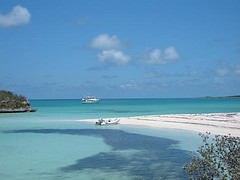
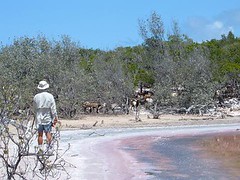
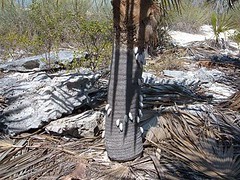
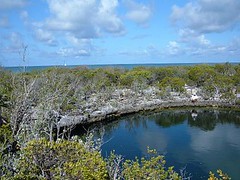
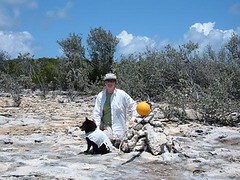
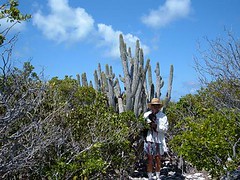








0 comments:
Post a Comment